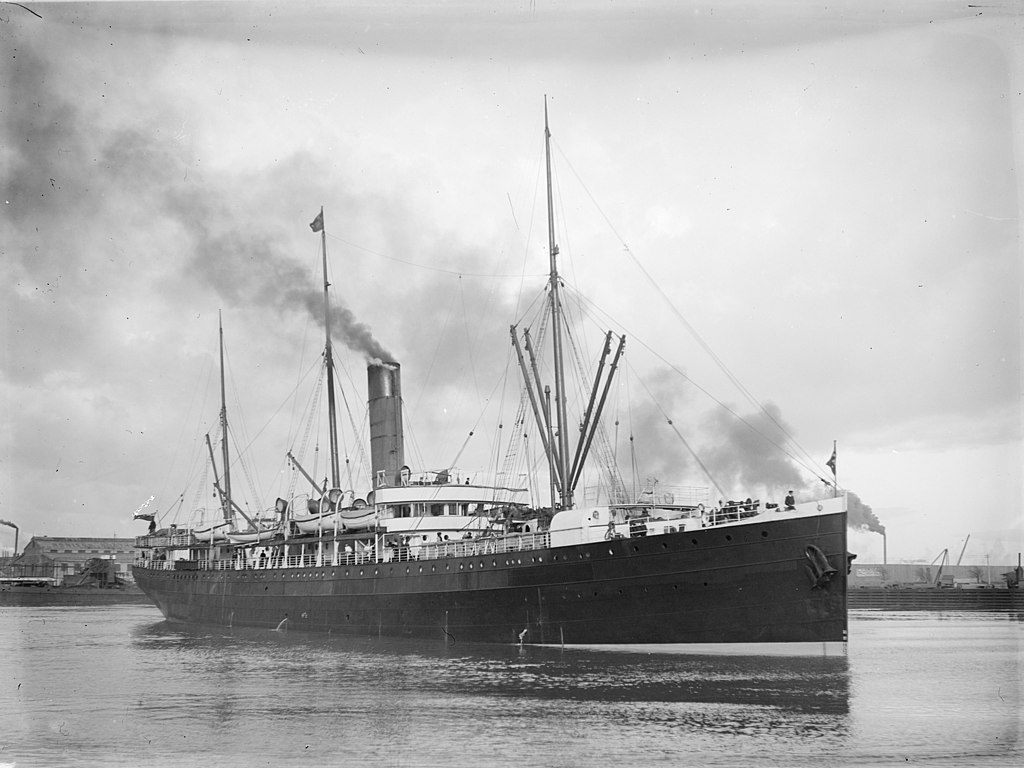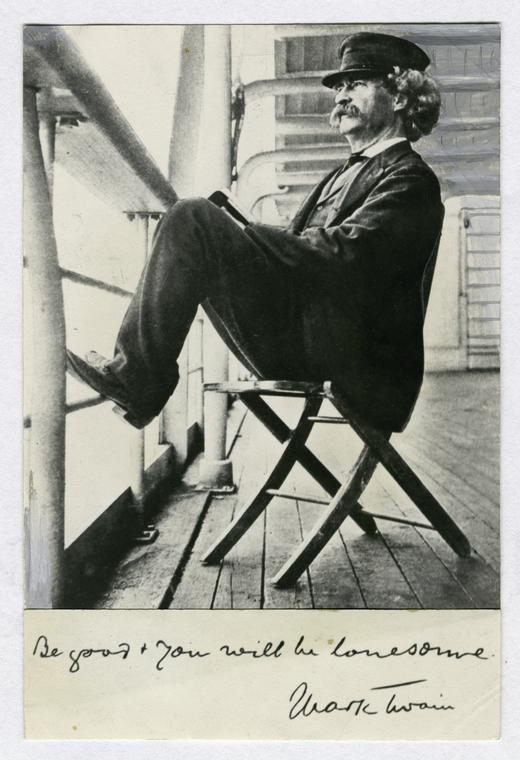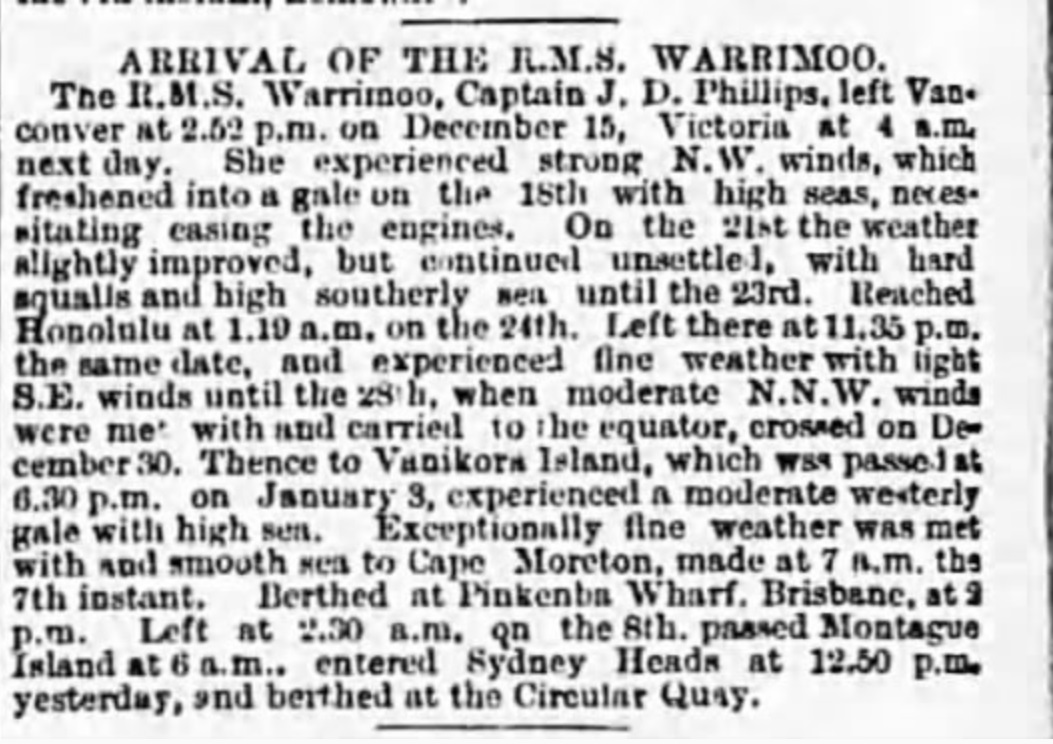
SS Warrimoo plied a trans-Pacific route from Canada to Australia, which means it crossed both the equator and the international date line on every trip.
On New Year’s Eve 1899, the captain of this Pacific liner steamed into history.
Or did he?
“BE GOOD AND YOU WILL be lonesome,” Mark Twain wrote under a photograph of himself.
The author sits on a folding chair, his feet on a ship’s railing.
Wearing a peaked cap and a grumpy face, he stares listlessly out to sea.
The picture was likely taken in 1895 on board SS Warrimoo, as Twain was crossing the Pacific from Canada to Australia.
It’s used as the frontispiece for Following the Equator (1897), a travelogue of his year-long round-the-world lecture tour.
The tour and his bad mood had a common cause: Twain was bankrupt.
A World Tour to Pay Off Creditors
In previous years, the former printer had sunk $300,000 of his (and his wife’s) money into an invention he thought would revolutionize printing, until then very much a manual, labor-intensive industry.
But the Paige Compositor, a mechanical typesetter, was a disaster.
Twain’s investment—about $9 million in 2022 money—was a total loss.
He embarked on his world tour to pay off his various creditors.
But the Paige Compositor, a mechanical typesetter, was a disaster.
Twain’s investment—about $9 million in 2022 money—was a total loss.
He embarked on his world tour to pay off his various creditors.

Twain, likely on the deck of SS Warrimoo, wasn’t exactly relishing the trip around the world.
While on board SS Warrimoo, Twain crossed the equator and the international date line, two events he noted in his book:
A sailor explained to a young girl that the ship’s speed is poor because we are climbing up the bulge toward the center of the globe; but that when we should once get over, at the equator, and start down-hill, we should fly.And a few days later:
Afternoon.
Crossed the equator.
In the distance, it looked like a blue ribbon stretched across the ocean.
Several passengers kodak’d it.
While we were crossing the 180th meridian it was Sunday in the stern of the ship where my family were, and Tuesday in the bow where I was.
They were there eating the half of a fresh apple on the 8th, and I was at the same time eating the other half of it on the 10th—and I could notice how stale it was, already.
The family were the same age that they were when I had left them five minutes before, but I was a day older now than I was then.
The day they were living in stretched behind them half way round the globe, across the Pacific Ocean and America and Europe; the day I was living in stretched in front of me around the other half to meet it.
Along about the moment that we were crossing the Great Meridian a child was born in the steerage, and now there is no way to tell which day it was born on.
The nurse thinks it was Sunday, the surgeon thinks it was Tuesday.
The child will never know its own birthday.
It will always be choosing first one and then the other, and will never be able to make up its mind permanently.
This will breed vacillation and uncertainty in its opinions about religion, and politics, and business, and sweethearts, and everything, and will undermine its principles, and rot them away, and make the poor thing characterless, and its success in life impossible.
Crossing the equator and the date line may have been memorable for Twain and other occasional passengers, but for the crew of SS Warrimoo, a steamliner plying a regular connection hauling mail, cargo, and passengers between Canada and Australia, it was just another day at the office.
The American satirist’s passage could have been the high-water mark (so to speak) of the ship’s wider notoriety, had it not been for an even more fateful encounter with both lines, a few years later.
A Prank of Historical Proportions
This happened on the evening of December 30, 1899, as SS Warrimoowas once more making the crossing from Vancouver to Sydney.
By chance, the ship was just a few nautical miles from the intersection of the equator and the date line.
Seeing a chance to pull a prank of historical proportions—big enough to be written about more than a century hence—Captain John Duthie Sydney Phillips ordered his crew to steer the ship toward the meeting point of both lines.
Five experienced navigators checked the position of the sun and, after sunset, the stars.
The ship’s position was checked every three hours.
Helped by smooth seas and open skies, SS Warrimooat the stroke of midnight found itself right across the aforementioned intersection, its bow pointing south and its stern facing north.
This happened on the evening of December 30, 1899, as SS Warrimoowas once more making the crossing from Vancouver to Sydney.
By chance, the ship was just a few nautical miles from the intersection of the equator and the date line.
Seeing a chance to pull a prank of historical proportions—big enough to be written about more than a century hence—Captain John Duthie Sydney Phillips ordered his crew to steer the ship toward the meeting point of both lines.
Five experienced navigators checked the position of the sun and, after sunset, the stars.
The ship’s position was checked every three hours.
Helped by smooth seas and open skies, SS Warrimooat the stroke of midnight found itself right across the aforementioned intersection, its bow pointing south and its stern facing north.

A lot comes together at the point where the international date line and the equator cross, about 2,000 miles southwest of Hawaiʻi and 2,500 miles north of New Zealand.
This chart shows the route across that point that SS Warrimoo attempted to take.
This had some positively mind-boggling consequences.
The forward part of the ship was in the Southern Hemisphere, where it was summer, and already January 1, 1900.
The aft part of the ship was in the Northern Hemisphere, where it was winter, and still December 31, 1899.
It could be said, therefore, that the same ship was, for a brief moment:in two different days (on its forward half, it was already Monday, while on its aft part, it was still Sunday);
- in two different months (forward in January, aft in December);
- in two different seasons (summer and winter);
- in two different years (1900 and 1899);
- in two different centuries (the 20th and the 19th); and
- in all four hemispheres at once (the southern and the northern on either side of the equator, and the eastern and western on either side of the 180th meridian).
Did This Really Happen?
However, like many stories that sound too good to be true, this one is as well.
It’s not that the story is entirely made up.
In 1942, the Ottawa Journalreported that Captain Phillips, now retired, was able to verify the whole thing from his logbooks.
And it’s not unheard-of for ships in the neighborhood to go out of their way to cross the equator on the date line.
In nautical lore, this makes you a “golden shellback.”
It’s doubtful that they would have been able to achieve and maintain a position that precise at the appropriate time.And in theory, it’s certainly possible for a ship on that specific point at a specific time to be in different days, months, seasons, years, centuries, and hemispheres.
However, even though the captain and his crew may have believed they were at exactly the intersection of the Great Meridian (180° E/W) and the equinoctial circle (0° N/S), it’s doubtful that with the navigational methods and instruments of that time that they would have been able to achieve and maintain a position that precise at the appropriate time.
And then, of course, there’s the matter of the new century.
As some may remember from the whole Y2K hullaballoo, centuries (and millennia) only end when the year ending in zero is over, not when it starts.
So, just like the 21st century and the third millennium started on January 1, 2001, the 20th century began on January 1, 1901, not 1900.
(Not that this chronological truth got in the way of popular opinion.)
Apart from that mention in the captain’s log, there is no record of that remarkable evening on board SS Warrimoo.
Mark Twain, had he been on board, probably would have had a witty thing or two to say about it.
However, being the unreliable narrator that he was, we still wouldn’t have known what actually happened.
Links :

No comments:
Post a Comment